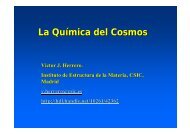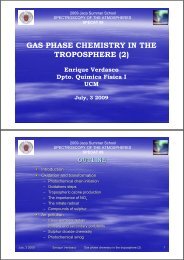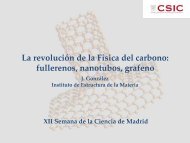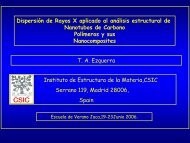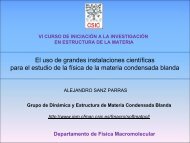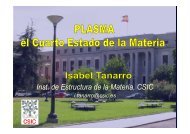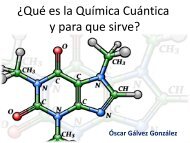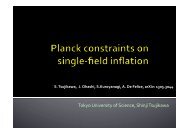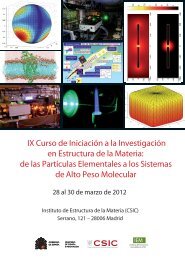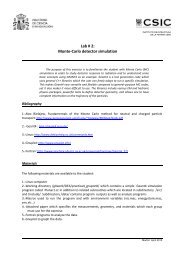ANNUAL REPORT 2011 - Instituto de Estructura de la Materia
ANNUAL REPORT 2011 - Instituto de Estructura de la Materia
ANNUAL REPORT 2011 - Instituto de Estructura de la Materia
Create successful ePaper yourself
Turn your PDF publications into a flip-book with our unique Google optimized e-Paper software.
Liquid hydrogen fi<strong>la</strong>ment (5 micron in diameter) at 15 K temperature, crossed by the exciting <strong>la</strong>ser at 100 micronoff the nozzleLASER SPECTROSCOPYThe bulk of the work carried out during <strong>2011</strong> in the Laser Spectroscopy line has been done using the Stimu<strong>la</strong>tedRaman Spectroscopy Technique in different configurations, studying several molecu<strong>la</strong>r species relevant in differentfields. The first one of those is 13 C 12 CD 2 , an isotopologue of acetylene that has been studied within the frameworkof an already well established col<strong>la</strong>boration with the University of Bologna. The main goal of this col<strong>la</strong>boration isthe precise mo<strong>de</strong>lling of ro-vibrational energy levels in the whole family of “common” isotopologues (mono- ordoubly- substituted with 13 C and D) of acetylene. In <strong>2011</strong> we have obtained room temperature stimu<strong>la</strong>ted Ramanspectra of the 1 , 2 , 2 + 4 - 4 , 2 + 5 - 5 , 2 +2 4 -2 4 , 2 +2 5 -2 5 , 2 + 4 + 5 - 4 -bands of this molecule. Moreover,using the Raman-Raman double resonance technique we have also recor<strong>de</strong>d the Raman spectrum of the 2 2 - 2 hotband at 160 K in non-rotational equilibrium at different pressures. Besi<strong>de</strong>s the information about the energy levelsof this molecule, the analysis of these spectra has revealed a J=2 propensity rule for the rotational re<strong>la</strong>xation of thismolecule. This propensity rule has been already observed for diatomic molecules, but it had not been observedbefore in a polyatomic, making this observation relevant enough as to be published as rapid communication in theJCP. The analysis of the rest of the bands has also been successfully finished and the results have been publishedseparately.The next studied species has been 12 CF 4 , a molecule that raises interest in atmospheric studies due to its <strong>la</strong>rge globalwarming potential (GWP) some 6000 times bigger than that of CO 2 , and its 50000 year lifetime in the atmosphere.We have obtained high resolution Raman spectra at room temperature of the 1 , 2 1 - 1 , 2 , 2 2 , 1 + 4 - 4 and 3 2 - 2bands, and 150 K spectra of 2 1 - 1 and the exten<strong>de</strong>d 2 band. The analysis of all these spectra is being done at theUniversity of Burgundy by our colleague V. Boudon.We have also conclu<strong>de</strong>d and published a study of the 13 C-substituted ethane ( 12 CH 3 - 13 CH 3 ) whose analysis has beendone in col<strong>la</strong>boration with Prof. N. Moazzen Ahmahdi of Calgary University, and another study on the N 2 moleculefor which we have measured with high precision the broa<strong>de</strong>ning by self-collisions at different temperatures.In the Difference Frequency Infrared <strong>la</strong>boratory, we have <strong>de</strong>veloped a method of precise wavenumber measurementusing a transfer cavity and an I 2 locked Ar + <strong>la</strong>ser as absolute reference. The termination of this system is pending ofthe procurement of a commercial wavemeter with an accuracy of 10 MHz. We have completed a preliminaryassessment of the performance of the system, yielding a S/N better than 1:2000. The accuracy of the wavenumberscale in this preliminary stage is ~2x10 -4 cm -1 , taking as reference the most accurate avai<strong>la</strong>ble frequencies for theP(7) multiplet of the 3 band of CH 4 measured with an optical frequency comb.Also in this <strong>la</strong>boratory we have started the set-up of an experiment aimed towards the acquisition of high resolutionstimu<strong>la</strong>ted Raman spectra with cw-<strong>la</strong>sers insi<strong>de</strong> a new type of optical fibers: hollow core photonic crystal fibers(HCPCF). The guiding mechanism in these fibers (the photonic band-gap effect) makes it possible to <strong>de</strong>sign a low-70




